Iditarod 2018 – Part 3: Don’s Cabin to Kaltag
Don’s “cabin,” a ten by twelve rundown shack, was a warm a comfortable place to stretch out the sleeping bag, and stay out of the blizzard that had hammered on us during the run from Ophir. It was also small enough that there was no risk of oversleeping as other mushers awoke and prepped to leave. After an hour of sleep, mushers around me started to rise and don their layers (looking and moving a little like zombies). A combination of rest and daylight seemed to calm people’s nerves about the trail conditions, and most seemed eager to get back to running.
The world outside of the cabin was still that of a snow globe, and all the dogs and gear were covered in a fresh layer of powder. My team perked their heads as I walked up to the sled, and they were all eager to have a frozen slice of beef. I started my cooker (melting snow to water), as the first teams in our group pulled the hook and departed the camp. In the hour it took for me to feed and repack the sled, six more teams left Don’s, and three other teams arrived: having made the trek from Ophir and all reporting the same conditions we had experienced.
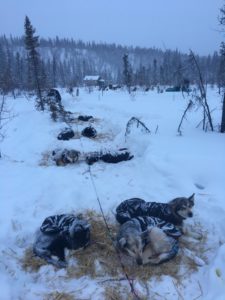
Qarth is wondering why I woke him up. Don’s Cabin in the background
I was ready for more snow and slow travelling, and I kept Qarth in lead, knowing the trail would be difficult. As soon as I pulled the hook and we left the protected area around the cabin, the wind was back and the trail was completely gone (even though, again, that next team was only 15 minutes in front of us). Conditions, however, did improve as we progressed down the trail, and there were only small sections that were completely obscured. This gave me the opportunity to do some sight-seeing as I ski poled along with the dogs (an action that helps to remove my weight from the runners and propel the sled down the trail).
It is hard to say what segment of this race was the prettiest, but this run from Don’s Cabin to Iditarod was certainly one of them. Rolling hills, with sparse tree coverage, gave great vantage points to look out across small alpine lakes. The calming snow and lifting clouds gave a few miles of visibility, and I was able to enjoy the beauty of the large valley we were travelling through. The winds were still steady, so intermittent drifts and windblown hills kept the mushing interesting.
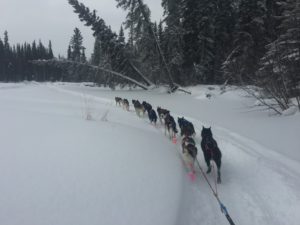
A brief bit of creek running between the hills
In total, this run took us just under seven hours for 40 miles. It was slow going, and the hills seemed endless. The dogs were in good spirits, but the last few climbs, into what was now a strong head wind, started to take its toll on their energy level. In addition, Frito developed a swollen wrist on the later part of the run, and needed to be loaded for the last hour. All in all, as we parked in Iditarod, I knew the dogs needed a longer rest and a few heavy meals. We ended up spending just over ten hours.
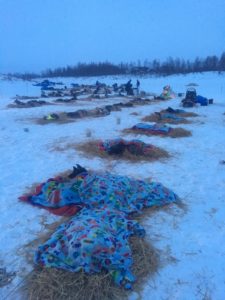
Catching some serious shut eye in the ghost town of Iditarod
This next leg of our race was probably one of the most enjoyable of the whole trip. The 65 miles to Shageluk is mostly hills, and the first half was supposed to be some of the hilliest of the whole race. Although the wind was still ripping over the hills, I had guessed there would be a more discernable trail, and decided to give Qarth a break from leading. Ambler and Tundra would make their debut, and I expected to keep a slower speed with those two up front (Tundra is our oldest racing dog at 10, and Ambler tends to be a bit of a monkey in lead).
In the first half mile out of Iditarod, we passed two teams (I had been the last team in our group to leave the checkpoint, and five of us were separated by only a few minutes). Allen Moore, running a young team of dogs, had been having some leader trouble, and was only a few hundred yards down the trail before he needed to stop and adjust a few dogs. As I went by, he was able to get his dogs rolling, and draft behind my team for the majority of the run. Together, we passed our second team only a quarter mile later.
Dogs tend to need time to warm up as they get off their straw and get back to running. Every group of dogs takes a different amount of time to stretch out and shake off, depending on how fast they have been running, what (and how much) they have had to eat on their rest, and what (if any) minor soreness and muscle injury they are needing to work out before they really settle in to pulling at 100 percent.
My team had been really quick to warm up all race, and this run was no exception. They were all in a smooth rythum by mile two, and Ambler was driving like a crazy man (probably going a little too hard, in hind sight). We hit our first hill at about mile three, and it was a good one: I looked up, and among the stars, was the light of Monica Zappa’s headlamp. With some quick pedaling, and my trusty ski pole in my right hand, we started the ascent. I could tell by the trail conditions, that Monica was breaking through small drifts and windblown patches, and footing was not very good. As we reached the summit of this first climb, I could see the outline of her team and watched her start a second hill. Ambler and Tundra were pumped to see Monica so close, and they drove hard to catch her midway up this ascent. We had a minor tangle on this pass, and we were both off the sleds to separate our dogs. Stepping off the trail, I was immediately waist deep in snow. We both had a good laugh about the ridiculous weather, and then got back to the trail.
By the time we peaked this second hill, the wind was a steady 30 miles per hour, and the gusts felt like they may halt us in our tracks. I was feeling great about the dog’s performance, however, and Ambler and Tundra were clearly having a blast running into the wind. In between strides of pedaling and ski poling, I would spin around and watch the line of headlamps behind us. Another team had joined our group from Iditarod, and there were four lights in a line moving through the blowing snow. It was a very cool image to be a part of.
Originally, sitting at home with a warm cup of coffee and an idealist mindset, I had planned to run straight through from Iditarod to Shageluk, 65 miles. Now, running a group of ten dogs at mile 500, and dealing with constant wind, I knew that a stop at halfway would be smart. Back at Iditarod, we were informed about a nice shelter cabin at mile 30. This would be our place to rest.

Just as the light was returning to the sky, we rounded a sharp bend and dropped onto the front step of the Big Yentna shelter cabin. A few other teams were parked and resting, and I got my team pulled off the trail and onto a large pile of used straw (it was clear that many teams in the race had also stopped here). I got the dogs settled and sleeping in short order (there are some advantages to a smaller team), and made my way into the cabin to catch some shut eye. The Iditarod Insider had a film crew at the cabin, and got me aside for a short interview. It felt a bit comical to be speaking into a camera in such a remote area.
After a few hours of rest, we were back on the trail and now mushing under a bright sun. The wind had abated, and it now felt downright warm. The dogs also felt the sun, and our speed was a bit diminished on our run to Shageluk. About two hours from the checkpoint, Ambler slipped in a hole and pulled his right shoulder. Now, having a 65 pound dog riding in the sled, our speed slowed a little more. One of our best runs of the race, was now followed by one of our worst. And that is the nature of Iditarod and long distance racing: highs and lows, one after another.
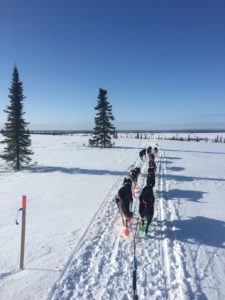
Approaching Shageluk
The arrival into Shageluk is pretty neat. As we crested our last hill of the run, we overlooked the Yukon River valley, and saw the mighty river for the first time. It is still quite far in the distance (Shageluk doesn’t actually sit on the river), but the valley makes quite an impression, and signals a significant step on the thousand mile journey to Nome.
The dogs did not eat particularly well in Shageluk, and I was feeling pretty demoralized having to drop Ambler. My spirits were boosted, however, having a good conversation with race judge Justin Savidis. He is a musher who I had not met, but heard really good things about. Having finished the seven previous Iditarods, he was able to give me some good insight into managing a small team for the next 450 miles (and also how to deal with the mental struggle of taking care of a sick dog team). The dogs, although improving since Rohn, had still been a little under the weather, with loose stools and a diminished appetite.
I left Shageluk feeling ready to tackle the next 200 miles. It would be exclusively river running, and we were very likely to be heading into a strong head wind as we worked up the river. Everyone looked good as we started this run, and the plan was to make the quick, 27 mile run to Anvik, and blow through to Grayling (18 more miles) and rest. This planned was quickly scraped, however.
As we snaked through a portage about two hours into our run, a moose jumped into the trail in front of the dogs, and encouraged everyone to hit the harness at 110 percent. Typically, this is not a risk for the dogs on a physical level, but being so far into a race, their bodies are not always ready for a quick change in speed and exertion. Polar, having been both physically and mentally one of the strongest on the team, gave all his energy to try and catch the moose. As soon as the animal was spooked off the trail, and the dogs settled down, Polar had a significant head bob. A clear sign that he had strained his shoulder, he now needed a ride in the sled.
So, Anvik was our next place to rest. Funny enough, this was the one place on the entire trail where I was sure I would not stop. As we were preparing food drops, I had reluctantly sent out enough food to stop for a couple hours, but had skimped on every other provision. Luckily, nine dogs do not need a lot, and temperatures were still pretty warm for me (so, extra gloves and socks were not essential).
As I rested the dogs, I took a serious look at the team and the rest of the race. Without Polar, I would be leaving Anvik with eight dogs, and be looking at the races longest stretch of unsupported trail. Eagle Island checkpoint was experiencing bad weather, and mushers would need to carry everything they needed for the 120 mile leg from Grayling to Kaltag. This would not have been a daunting task with a larger team, or with a smaller group of dogs that were not 550 miles into a challenging race. At this point, however, I felt some hesitation about continuing.
There were a few factors that kept me going, and got us out of Anvik. As I pulled into the checkpoint, I met up with Peter Fleck, a musher who was running a puppy team for Mitch Seavey, and a guy with a very positive outlook on life. He was a good reminder to keep having fun, and always focus on the team members that are strong and doing well (don’t get bummed by the negative). He also helped me analyze the Yukon River run, and determine how to get to Kaltag in the best manner (having made this unplanned stop in Anvik).
I also had a chance to chat with Katti via messenger. Although she was not travelling the trail, she was able to remind me that we had trained the majority of the winter with small teams, and eight dogs can easily cover hundreds of miles. This was a very good boost, and lifted my spirits a bit. I was also motivated by the fact that I did have eight healthy dogs who were eager to keep going. I owed it to those dogs, if no one else, to keep traveling and help them have a good and successful race. As long as I could set them up for success, we could still make it to Nome and have a good time getting there.
After six hours, we pulled the hook and left Anvik. I would resupply in Grayling, and make two breaks (three runs) over the next 140 miles to Kaltag. As long as the weather wasn’t too brutal, I figured our chances of making it were good. As it turned out, the run up the Yukon River was great! The dogs performed well, ate well, and seemed to be kicking their stomach bug with the help of some high powered antibiotics.

A few miles from Grayling
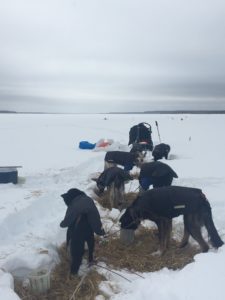
Our first rest on the Yukon
The end of our first leg on the river, had us resting about 25 miles north of Grayling. I found a protected spot out of the wind (rare on this river), and in the sun. The dogs enjoyed a perfect rest during the warmest part of the day. The second leg of our run was easy going with only minimal wind. The only point of interest on this run, was a brief bit of hill climbing around midnight…
Without warning, trail markers appeared hundreds of feet above us, and the trail started up this long climb. The dogs slowed with the ascent, and I started ski poling and pedaling with vigor. After a couple minutes, we reached no clear summit, and suddenly started dropping in elevation. The dogs picked up, and I threw the ski pole on the sled, riding the drag to slow us down. The dogs gave me a serious look back, and I let off the drag a bit. I shut my eyes for a long blink, as we continued our descent. As I re-opened them, I realized we were still traveling the mile wide Yukon River. It has no hills. I was hallucinating.
Our second stop on the Yukon, was about 15 miles north of Eagle Island. I felt very fortunate to find another calm and protected spot on the river, and made a comfortable camp for me and the team. After a quick meal, and a bed of straw for the dogs, I was zipped up in my sleeping bag and sound asleep. I then proceeded to sleep through my two alarms, and the half a dozen teams that passed.
I awoke at exactly the time I had wanted to leave. Snow was falling steady, and a breeze had picked up. I jumped out of my bag, feeling very much in a panic, and got the cooker going (the dogs still needed a soup and snack before hitting the trail). Being hit with a wind in our camping spot, I knew the middle of the river would be in a full-fledged storm as we got moving.
After a total of seven and a half hours, we were off our straw and rolling down the trail. Mereen and Knox were in lead together at this point, but that changed as we hit the first exposed section with no trail. After a couple adjustments, Qarth found his way back to single lead, and took us plodding into blowing snow and drifting/disappearing trail. Although it was getting close to white-out at this point, sun glasses were still essential as the blowing snow had the texture of sand. This also affected the glide of the sled runners, and the progress up river was slow and taxing for the dogs. By the time we reached Kaltag, we had been running for almost nine hours to cover 50 miles, and the dogs were fighting belly deep drifts for much of the last 20 miles. Despite the slow going, however, their attitudes remained perky, and they pulled off the Yukon looking healthy and ready for more trail (as long as it did not involve more river).
